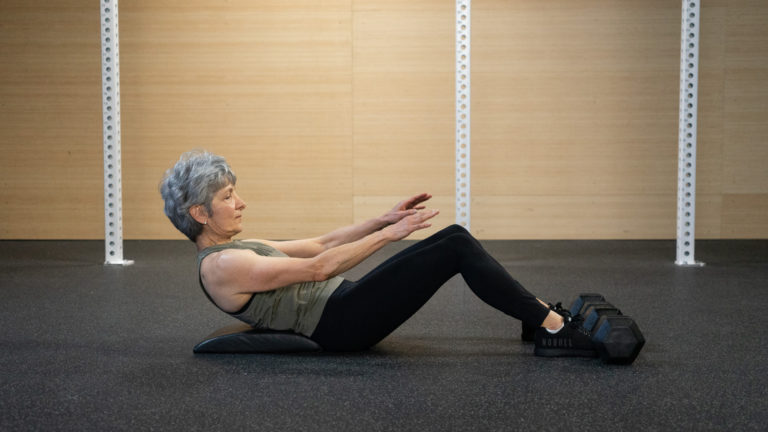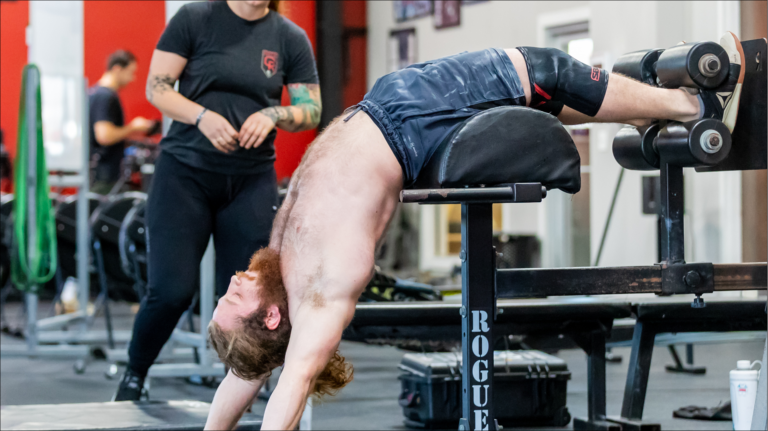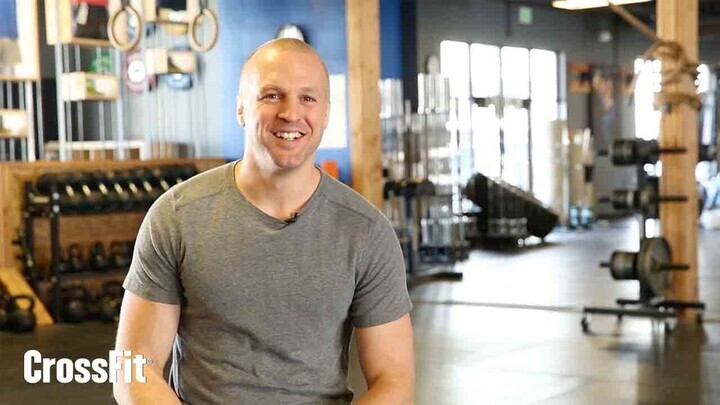Question: Hey, coach, why do we use the AbMat?
May 7, 2025
Question: Hey, coach, why do we use the AbMat?
The AbMat, or a similar tool, is familiar to most CrossFit gyms, and your members may ask why we use them. Many think it’s simply to avoid excessively rubbing the lowest portion of the back on the floor, which can cause irritation and bruising. While this may be an added benefit, this is not the rationale for using this tool. The following is intended to provide some context on utilizing the AbMat and to tackle some common questions.
 The primary rationale for the AbMat is that it allows the abdominals to work dynamically — to create movement — throughout a larger range of motion compared to completing sit-ups without the AbMat. Where the primary role of the abdominals in functional movements is largely isometric (no movement) to provide stability around the trunk, athletes can gain some introductory strength and capacity by developing the abdominals dynamically.
The primary rationale for the AbMat is that it allows the abdominals to work dynamically — to create movement — throughout a larger range of motion compared to completing sit-ups without the AbMat. Where the primary role of the abdominals in functional movements is largely isometric (no movement) to provide stability around the trunk, athletes can gain some introductory strength and capacity by developing the abdominals dynamically.
The dynamic use of the abdominals through a large range of motion is due to the AbMat filling the gap between the lower back and the floor. When the athlete performs a sit-up with the AbMat, their back has something to push into for a more extended range of motion than a sit-up executed without it. When the lower back has something to push into, the abdominals will aid in creating the movement. When your back loses contact with the ground, the abdominals will stop working dynamically and work isometrically, as the hip flexors work dynamically to elevate the trunk.
To get an idea of how the AbMat encourages the use of the abdominals to create movement, do the following drill:
Step 1: Start lying on the floor with your back on the ground and your lower body in the classic “butterfly” stretch position.
Step 2: With NO AbMat, attempt to perform a sit-up without utilizing momentum.
Step 3: Starting in the same position, put the AbMat under your lower back.
Step 4: Perform the sit-up without utilizing momentum.
Bonus: To remove the contribution of the hip flexors further, keep the butterfly position of the lower body static throughout the rep. Do not allow your feet to move away from the body, and do not allow the knees to move upward and inward throughout the rep.
Without the AbMat, most athletes fail when their back lifts from the floor because the butterfly position weakens hip flexors and prevents effective abdominal engagement. The AbMat provides crucial lower back support through a greater range of motion, enabling proper abdominal activation and successful completion of the movement.
Using an AbMat for sit-ups is optional, but recommended. The AbMat offers several advantages: It promotes more effective abdominal engagement during the exercise and may reduce lower back pain by decreasing the demand on hip flexors that would otherwise pull on the spine during the movement.
You can substitute the AbMat with alternatives such as rolled-up towels or gym mats that similarly fill the gap between your lower back and the floor, achieving comparable benefits.
No, the strictly controlled variation of the AbMat sit-up, with the lower body positioned in a static “butterfly” position, is recommended to be performed before or after workouts to allow for a focus on quality and control. This movement can be scaled by positioning the legs differently or using the hands to assist with pressing off the floor.
During workouts like Annie — 50-40-30-20-10 reps for time of double-unders and AbMat sit-ups — where the goal is to complete the task as quickly as possible, it is acceptable to bend the legs with knees pointing toward the ceiling and even have the feet anchored to allow for the quickest reps to be completed throughout a high volume.
 The AbMat sit-up can round out a direct trunk training movement repertoire. Consider the following movements and analyze the variety of functions of the abdominals:
The AbMat sit-up can round out a direct trunk training movement repertoire. Consider the following movements and analyze the variety of functions of the abdominals:
AbMat sit-up: Abs are responsible for dynamic movement action.
L-sit: Abs are static while the hip is in a flexed position
GHD sit-up: The abs are largely used for stability (although the trunk moves slightly), while the hip flexors contribute to the dynamic action’s position.
Plank: Abs are responsible for stabilization while the hip is extended.
Although this is not an extensive list, it is easy to see how the movement complements other abdominal-related exercises commonly performed in CrossFit workouts.
Registration for the Community Cup begins May 12!
Have a question for a coach? Please submit that here.
 Eric O’Connor is a Content Developer and Seminar Staff Flowmaster for CrossFit’s Education Department and the co-creator of the former CrossFit Competitor’s Course. He has led over 400 seminars and has more than a decade of experience coaching at a CrossFit affiliate. He is a Certified CrossFit Coach (CF-L4), a former Division 1 collegiate wrestler, and a former CrossFit Games athlete.
Eric O’Connor is a Content Developer and Seminar Staff Flowmaster for CrossFit’s Education Department and the co-creator of the former CrossFit Competitor’s Course. He has led over 400 seminars and has more than a decade of experience coaching at a CrossFit affiliate. He is a Certified CrossFit Coach (CF-L4), a former Division 1 collegiate wrestler, and a former CrossFit Games athlete.